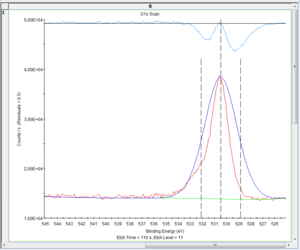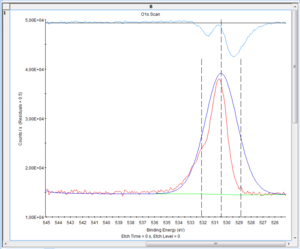Specific Process Knowledge/Characterization/XPS/Processing/Basics/3fitting: Difference between revisions
Appearance
No edit summary |
|||
| Line 1: | Line 1: | ||
'''Feedback to this page''': '''[mailto:labadviser@danchip.dtu.dk?Subject=Feed%20back%20from%20page%20http://labadviser.danchip.dtu.dk/index.php?title=Specific_Process_Knowledge/Characterization/XPS/Processing/Basics/3fitting click here]''' | '''Feedback to this page''': '''[mailto:labadviser@danchip.dtu.dk?Subject=Feed%20back%20from%20page%20http://labadviser.danchip.dtu.dk/index.php?title=Specific_Process_Knowledge/Characterization/XPS/Processing/Basics/3fitting click here]''' | ||
<!--Checked for updates on 30/7-2018 - ok/jmli --> | |||
== Fitting the oxygen O1s core level == | == Fitting the oxygen O1s core level == | ||
Revision as of 12:52, 30 July 2018
Feedback to this page: click here
Fitting the oxygen O1s core level
There is a few choices to make on the fitting of the O1s level. The level is an s-orbital and thus gives rise to a peak that is symmetric so any non-symmetric appearance must be caused several states of oxygen. The question is then to which states of oxygen they should be attributed. Below are shown the spectra of levels 0 (surface), 11 and 20.
We can establish that
- The main peak remains at fixed binding energy, and
- There is a shoulder at higher binding energy



